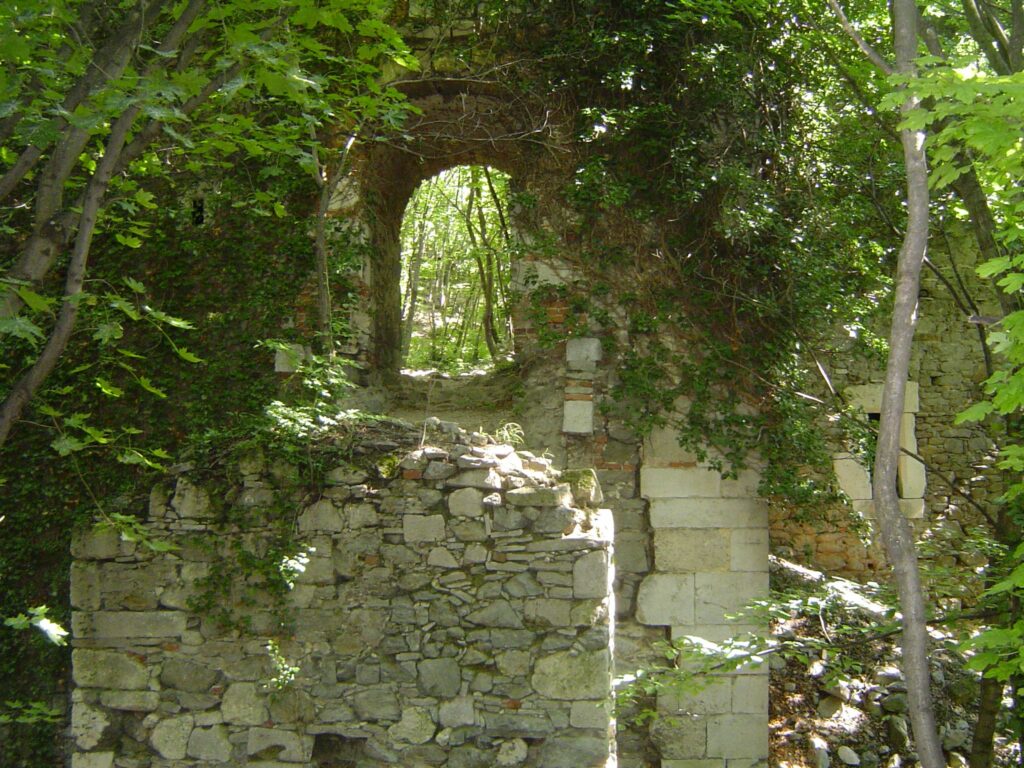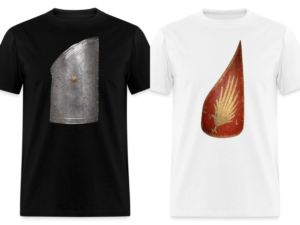This lesser-known, unexcavated ruined castle is a gem, it is located in Austria but was built in the Kingdom of Hungary, but after the death of King Matthias Corvinus, the owners switched sides and joined Austria. Location on the map: https://rb.gy/kta20i

In 1208, Mannersdorf and the nearby settlement of Hof belonged to Pat (Botho), a lord of Moson from the Győr clan, who received them from King András II for his loyalty and unfailing strength of honor. In 1233 the two villages were plundered. Palatine Dénes fined the plunderer. The castle of Sárfenék was built on the hill between the two villages at the end of the 14th century.

The naming of the castle of Sárfenék / Scharfeneck / Élesszeg is unclear in Hungarian literature. According to Nagy Imre, the original name of the castle may have been Sárfenék, which the German users of the name changed to Scharfeneck (sharp angle, corner). The Hungarian translation of this appears in 1469: “(castrum Sarffeneck al. nom. Eeleszeg”. Engel Pál, on the other hand, thinks that the castle built after 1390 by the sons of Scharfenek János may have been named after the family name, which was Hungarianized as Sárfenék. The surname Scarfeneck appears as early as 1376 when the royal castellan of the newly built castle of Talmács in Transylvania was Scharfeneck János.

On April 24, 1390, King Zsigmond (Sigismund) authorized Scharfenek Frigyes to take the castle of Köchee [Köpcse] and its appurtenances, which was donated to him and his brother Herman:
Koche, Pawmen also known as Kewrtweles, Menesdorf also known as Menhart, and the villages of Hof, to sell or mortgage them to anyone, but stipulated that the castle and its appurtenances “de regno nostro Hungarie ac sacra corona per huiusmodi vendiiionem aut obligationem” may not be alienated. This charter did not mention the castle, so it must have been built after this date. As a border castle, it secured the western border of the Kingdom of Hungary.

The chronicles tell of numerous border skirmishes between the lords of the castle and the lords on the Austrian side of the border. In 1396 the Scharfenecks sacked the Austrian Deutsch-Altenburg, and in 1408 Stuchs von Trautmannsdorf attacked the castle, for which his lords took bloody revenge on the Trautmannsdorf estates in 1412.
After the family was disconnected in 1417, it became a royal castle. On 21 December, King Zsigmond mortgaged it together with the castle of Köpcsény to the widow of Ulrik Wolfurth of Wereskew, Catherine and her children Imre, Pál, Jakab, Ilona, Orsolya, Zsuzsanna and Hedvig. In the document, the castle was listed as Newscharff.

In 1440, Wolfarti Pál died without an heir, and his widow Gitka (Judit), Princess of Troppau, married Bazini Gyögy of the Hont-Pazman clan. Sárfenék, Vöröskő, and Óvár also became the property of the Bazini and Szentgyörgyies, but the female descendants of the Wolfart family, Elderbach of Monyorókerek and Széchy Miklós, also sued him. This lawsuit dragged on for decades, with the parties going head to head in a duel to prove their case.
On November 17, 1450, Pálóczi László, the king’s judge, granted the castles of Vöröskő (“Wereskew”), Óvár (“Owar”) and Sárfenék (“Sarfnyk”) to Miklós, son of Szécsi Miklós, and Elderbach Pertóld of Monyorókerék, against György, Count of Bazin, and his sons, who did not appear for the duel on the appointed day.

In 1451, based on a judgment of the county judge, the men of the Buda chapter went out to the castle of Óvár in Moson county, the castle of Vöröskő and the castle of Sarfnyk and the town of Monesthorff and the estates of Hoff, Aw and the 12 places in the town of Samaria in Sopron county as part of the castle of Sarfnyk. Elderboh Pertholdus of Monyorokerék and Miklós son of Miklós of Zeech were admitted to the ownership of the castles and their appurtenances, against the counts of Szentgyörgyi and Bazin.
In 1455 it was listed as Castrum Sarfenek, in 1458 as Castrum Sarffnek. At that time, Elderboch Bertoldus of Monyorokerek gave up his share in the castles of Sarfenek, Óvár, and Vöröskő in favor of the Szentgyörgyis.

According to a charter dated 30.07.1460, Kápolnai László of Scharfeneck agreed with his lords, Counts Szentgyörgyi and Bazini János and Zsigmond, that if his wife Dorottya died before him, then after her death, as soon as the two counts paid the stipulated thousand gold forints, the castle of Scharffenegk would be handed over to them. In 1464, Jorg Welser was the castellan of Scharffenegg.
On September 20, 1465, Count Bazini and Szentgyörgyi Zsigmond, Transylvanian Voivode, and Székely Comes, informed the city of Sopron that there was a 400-strong army of foot and horse at Sárfenék (“Scharphenek”), which would soon grow stronger. If they need help against Hinko, they should contact their captain.

In 1469 the Counts of Szentgyörgyi and Bazini sold the manor to King Matthias for 6000 forints. In 1470, King Matthias sold the castle of Scarfeneck to Ulrich von Grafeneck, a mercenary general, for 24,000 forints, and exempted the manor forever from paying treasury tax, war tax, and all ordinary and extraordinary taxes.
On 2 July 1481, before Báthori István, the judge of the country, Bazini, and Szentgyörgyi János and Zsigmond, with Szécsi Miklós and his children, were reconciled in a lawsuit for the castles of Óvár, Vöröskő, and Sárfenék, and the counts of Bazini obliged themselves to pay Szécsi 3000 gold forints and to deliver four silver plates. Sárfenék, however, was not really theirs at that time, it was owned by the Grafeneck family. After Grafeneck’s death, the castle of Sárfenék was occupied and sacked by Hungarian troops.

The Treaty of Pozsony of 1491 between King Ulászló II and Maximilian Habsburg also regulated the castle of Sárfenék:
“The castle of Scharfeneck, however, shall be surrendered to the King or to whom it may be due only when King Ulászló finally returns the above-mentioned castles to the Emperor, so that this return shall take place from both parts at the same time. It is further decreed that King Ulászló shall arrange for an honest guardian for the sons of the late Ulrich von Grafeneck, who shall take over the castle of Scarfeneck from the Roman king or his subjects at the time. And he shall faithfully keep it for the said sons, together with the rest of their property, and when they come of age he shall return the castle with its appurtenances and other property, and shall make an account of the income and expenditure.”

Later on, Maximilian I probably bought out the Grafenecks in Sárfenék. In 1495, the Prüschenk brothers collected the tax, then the estate was given to Paul Waser and from 1501 to 1506 to Johann Neidegger. In 1504, the property was transferred to the property of the younger Neuhaus in 1504. Ulrich von Grafeneck sold his claim to Scharfeneck to Veit von Fürst, who bought it from Maximilian I in 1506 for 3000 Rhenish forints. The Emperor retained the right to buy it back, which he did 10 years later.
On 4 November 1517, Christoph von Zinzendorf received the manors of Kismarton and Scharfeneck as pledges. Austrian sources at that time described it as belonging to the county of Sopron. In 1523, Waltinger István was the castellan of Sárfenék. In 1536 Ferdinand I allowed Wolfgang Brandtner to ransom the manor, despite the objections of Zinzendorf’s son.

In 1555, a lightning strike caused the upper floor of the old tower to collapse. In 1558 the owner, Max von Polheim, enlarged the castle. In 1568 his widow inherited the castle and its appurtenances, but by then they no longer lived in the castle and moved to Mannersdorf Palace.
In 1644, the Carmelites founded the monastery of “St. Anna in der Wüste” under the castle hill and surrounded the area with a stone wall. The walls ran right up to the castle.

According to Act 78 of 1659, King Leopold I, after hearing the interested parties, promised the reattachment of the castle and its appurtenances. This did not happen and it remained in the possession of Austria.
In 1683, during the last Turkish siege of Vienna, the people of the area, some 3000 people, fled to the castle walls to escape the Turks. The Tatars, who were on the march, surrounded the castle and tried to starve the defenders, but they did not surrender to the besiegers, despite the starvation. According to local legend, recorded in 1840, the Tartar leader took shelter in a monastery under the castle, but when his coffee cup was shot from the castle with a cannon, he fled in terror.

The castle was used by the locals even during the Rákóczi War of Independence, during the Kuruc raids.
In his “Notitia hungariae novae historico geographica”, Bél Mátyás noted in the section on Sopron County that the dispute between the county and Austria over the borders was pending. The county of Sopron declared that Hof, Manersdorf, and Scharffenek belonged to the county by right, although they are now in Austria.
(“Consulto ita loquimur, ne siluisse videamur, litem, de Hungáriáé, atque Austriae finibus adhuc pendentem, et frustra hucusque agitatam. Sempronienses certe, ad suum Comitatum, veterrimo iure pertinere aiunt: Hoff, Manersdorf Scharffenek, et vicos alios; tametsi hodie Austriae limitibus contineantur.”)

The castle was abandoned and the forest gradually overgrew. Today, the old tower stands several meters high, and the castle walls are 10 meters high in places. They are up to 6 meters thick. It is better to visit when there is no foliage.
How to get there:
South of Mannersdorf am Leithagebirge, in the middle of the Lajta mountains, on a north-western hilltop, rise the ruins of the castle of Élesszeg, also known as Sárfenék. Leaving Mannersdorf to the southwest, you reach the Arbachmühle Inn.

The Naturpark has developed a large car park in recent years, so don’t use the inn car park! From the Naturpark area, you can continue on foot along the Arbach stream. Just at the beginning of the path you will pass the remains of the wall of the chapel of St. Léopold and then the ruins of the former monastery of the “Carmelite Order. Continuing down the valley, at the “Fuchsbründl”, before the fork in the road, follow the signposted path southwards to the castle.
Source: http://www.varlexikon.hu
Dear Readers, I can only make this content available through small donations or by selling my books or T-shirts.
If you like my writings, please feel free to support me with a coffee here: https://www.buymeacoffee.com/duhoxoxa
You can check out my books on Amazon or Draft2Digital, they are available in hardcover, paperback, or ebook:
or at https://books2read.com/b/boYd81 and https://www.amazon.com/dp/198020490X


My work can also be followed and supported on Patreon: Become a Patron!http://Become a Patron!

https://hungarianottomanwars.myspreadshop.com/
Here are more pictures of the castle:





























